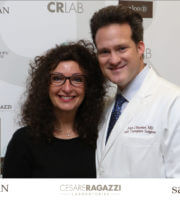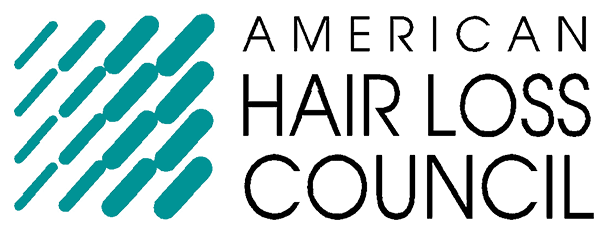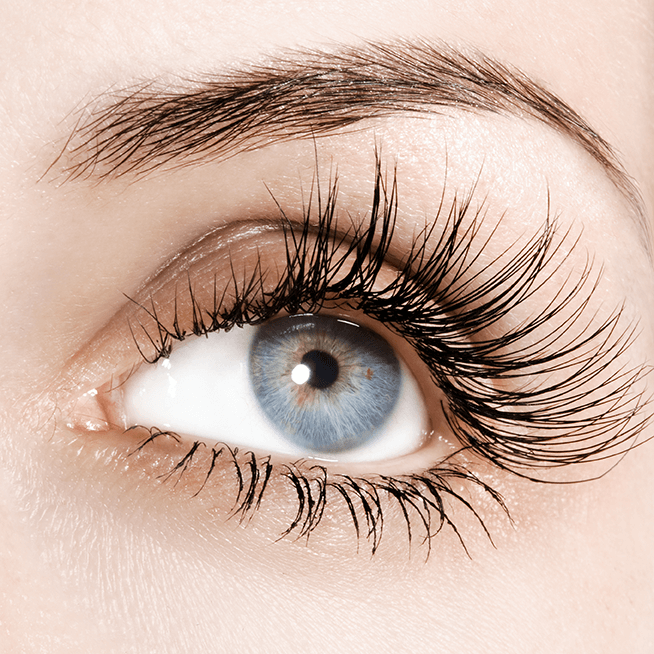Shedding Light on Alopecia Areata
by Alan J. Bauman, MD, ABHRS
[Photo: Dr. Alan Bauman with Alopecia Areata patients Charlie Villanueva and Claudia Cassia at Bauman Medical in May 2016]
September is Alopecia Areata Awareness Month and it’s an important opportunity for those suffering from alopecia areata and other less common forms of hair loss, like cicatricial (scarring) alopecia, to get educated about effective new hair restoration options that can help.
About Alopecia Areata
According to the National Alopecia Areata Foundation, over 6.8 million people in the U.S. have, had, or will develop alopecia areata at some point in their lives. Unlike androgenetic alopecia (common male and female hereditary or “pattern” hair loss), alopecia areata is an autoimmune disorder in which the body’s immune system mistakenly attacks the hair follicles, resulting in the sudden loss of hair. Most often, hair loss occurs in small circular zones, with the hair itself coming out in clumps, leaving smooth, bald patches of varying sizes on the scalp, beard, or elsewhere on the body. Depending on the type and severity of alopecia, sufferers may experience one or more small bald patches on the scalp that spontaneously regrow, or it may progress to full cranial hair loss called alopecia totalis, including eyebrows and eyelashes, or total body hair loss, otherwise known as alopecia universalis.
Alopecia Areata is an autoimmune condition that suddenly causes one or more small round bald patches to appear with hair falling out in clumps.
What Causes It?
Unfortunately, at this time, we don’t know exactly why the immune system attacks the body’s own hair follicles, but it is believed that genetic factors may contribute to the condition as nearly 20% of affected people have a family member with the condition. Certain other factors, such as extreme psychological stress, physiological stress, or even allergies, can trigger the condition in some people, but there is little evidence to support that stress on its own may be to blame.
Those who are affected by alopecia areata are more likely to suffer permanent hair loss if they:
- Have a family history of the condition
- Show signs of alopecia before puberty
- Have the condition for periods of more than a year at a time
- Have extensive hair loss
- Have another autoimmune disease
- Are prone to allergies
- Have fingernails or toenails with abnormal coloring, shape, texture, or thickness
Treatment Options
While medical treatments for hair loss have advanced dramatically over the last few decades, there is no true cure for alopecia areata. However, in recent years, we’ve seen continued improvement in treating these rarer forms of alopecia.
The most common treatment for patchy hair loss associated with alopecia is a course of corticosteroid injections into the scalp or skin. Corticosteroids may also be applied topically directly to the affected areas, as is often the case with younger children. PRP, or Platelet Rich Plasma injections, are a non-pharmaceutical treatment option with fewer side effects that have been reported to be successful in some cases, especially when combined with ECM (Extracellular Matrix) for added effectiveness.
Sometimes, these treatments are given in tandem with topical applications of over-the-counter minoxidil. If a less greasy and stronger version is desired, compounded Formula 82M minoxidil may be prescribed.
For those who haven’t been successful with available treatment options and are seeking an alternative to traditional wigs, weaves, hats or scarves, they might want to consider a durable high-quality medical-grade prosthetic hair system called a “CNC.” These cranial prosthetic devices are made with a 3D-printing process to allow each to be custom-fitted to the patient’s scalp and precisely match their skin color, often called a “second skin” or “second scalp.” 100% unprocessed human hair of appropriate color, curl, and length is then meticulously implanted in natural hair growth patterns. Painstakingly handcrafted in Italy and applied with a medical-grade adhesive, they allow patients to shower, shampoo, swim, dance, play sports or even skydive, and to style their hair normally. With monthly service appointments, these comfortable, high-end hair and scalp prosthetics last for years and are virtually indistinguishable from one’s own natural hair, allowing those with extensive hair loss to have a completely full head of hair.
And looking ahead, recent studies are demonstrating that a powerful class of anti-inflammatory drugs called Janus Kinase (JAK) inhibitors are likely to play a crucial role in the treatment of alopecia areata in the future. JAK inhibitors have not only been shown to effectively treat hair loss and stimulate regrowth in alopecia areata but may also be able to stimulate growth in the androgenetic alopecia. More research and studies are currently underway, but this is a promising treatment option for sufferers.
Education and Awareness
Even if you’ve never been affected by the condition, there remains a chance that it could still affect you. As with all hair loss, the best means of prevention is to maintain a healthy scalp, and that is best accomplished by enjoying a good diet, alleviating stress, and avoiding harsh chemicals or environmental factors that can trigger the immune system.
Perhaps one of the best ways to combat alopecia, however, is through education. The more we understand about the condition, the better we will be able to treat it in the future and to accept it in the meantime.
For more information on alopecia areata, or to learn what treatment option may be right for you, please visit www.baumanmedical.com or call 561-220-3480.
Sidebar:
September is also Menopause Awareness Month, here are a few takeaways for women at risk for hereditary hair loss:
A woman’s chance of losing hair after menopause is almost just as high as it is for men at that age, but female pattern hair loss looks different.
Female hair loss typically causes diffuse loss of hair behind the frontal hairline but it can also cause a less feminine, receding hairline in the temples.
It’s easy to miss the early warning signs of female pattern hair loss – but catching it early is key, as 50% loss can occur before it’s noticeable to the human eye. There are a number of effective treatments for female hair loss, but the best results occur when they’re started early on.
Hair loss around menopause is common due to changes in hormone levels and activity, but it cannot be commonly cured with hormone replacement alone.
Genetic predisposition, unusual levels of stress, hormonal imbalances, vitamin deficiencies, crash diets, medications, styling habits, as well as a history of illness and surgery can also be contributing factors to female hair loss.
Most women benefit from a combination of pharmaceutical and lifestyle changes in treating their hair loss and thinning. Results are proportional to your level of discipline and compliance with the prescribed regimen and how early you begin treatment.
Medical treatments to protect and enhance hair follicle functioning may include compounded topical minoxidil Formula 82M, platelet-rich plasma injections, Latisse/Bimatoprost or other prostaglandin analogs, low-level laser therapy, off-label anti-androgens (for post-menopausal women only) and nutritional supplements like Viviscal Professional, Nutrafol Female Core Plus, and pharmaceutical grade biotin.
*Each individual's treatment and/or results may vary
If you or someone you know has hair loss, hair thinning, baldness, or eyebrow / eyelash concerns, click to start either a long-distance virtual consultation OR an in-person, in-office consultation with Dr. Bauman. You can also Ask Dr. Bauman a Question or simply call Bauman Medical Group at +1-




 Press Release: Alopecia Areata Awareness Month: New Treatment Utilizes 3D-Printing Technology
Press Release: Alopecia Areata Awareness Month: New Treatment Utilizes 3D-Printing Technology Frequently Asked Questions About PRP For Hair Regrowth FAQs
Frequently Asked Questions About PRP For Hair Regrowth FAQs VIDEO: Beyond The Technique Host Kati Whitledge Interviews Dr. Alan Bauman On “What Is Alopecia?” For Her Podcast
VIDEO: Beyond The Technique Host Kati Whitledge Interviews Dr. Alan Bauman On “What Is Alopecia?” For Her Podcast The best hair restoration treatments for alopecia
The best hair restoration treatments for alopecia Dr. Alan J. Bauman, M.D.Hair Loss & Hair Transplant ExpertBoca Raton, FL
Dr. Alan J. Bauman, M.D.Hair Loss & Hair Transplant ExpertBoca Raton, FL






